Beeswax is a 100% natural product. It may surprise you how incredibly versatile beeswax is. It is used in many products from candles to cosmetics, car polish to surfboard wax and mustache wax to eco food wraps. Just another reason the humble honey bee is one of the most valuable creatures on our planet. The question is how do bees actually make beeswax and what do they use it for in their hive?
Worker bees at 10 to 20 days old produce wax from wax glands under their abdomen. Gorging themselves on honey triggers the wax glands to produce a liquid wax secretion. The wax dries and flakes off and is collected by worker bees. These bees use the wax to build, cap, or repair combs in the hive.
Check out the video below to see a honey bee with its abdomen loaded with these wax flakes.
At what age do bees make wax?
Honey bees function in incredibly organised and efficient communities. They are all allocated age specific roles to perform within this community. A bee is able to produce wax within 10 to 20 days of emerging from the cell and beginning their life.
Around day 10 of the bees life, the young bee gorges itself on honey which activates wax glands. There are eight wax glands in four pairs located on the inside of the fourth to seventh abdominal plates on the bee’s abdomen.
Their wax production increasingly grows on average until day 21. It’s at this point that these wax producing bees will transition to field bees. This natural progression to field a bee means they are now ready to leave the hive to forage for nectar and pollen.
When this happens the wax glands shrink and waste away. The remainder of the bees life is now solely dedicated to foraging for nectar and pollen.
When do bees make wax for the hive?
The number of bees and amount of wax produced depends on the needs of the individual hive at any given time. Honey bees instinctively know to increase honey production when there is strong availability of pollen and nectar needed for the growth of their colony.
Wax and honey production is seasonally affected. During Spring when pollen and nectar become more readily available the bees will look to rapidly increase brood production. The brood is the wax combs that the queen lays eggs in. Increased brood production will require more wax combs for the queen to lay eggs in.
See below freshly drawn combs with new worker brood in production.
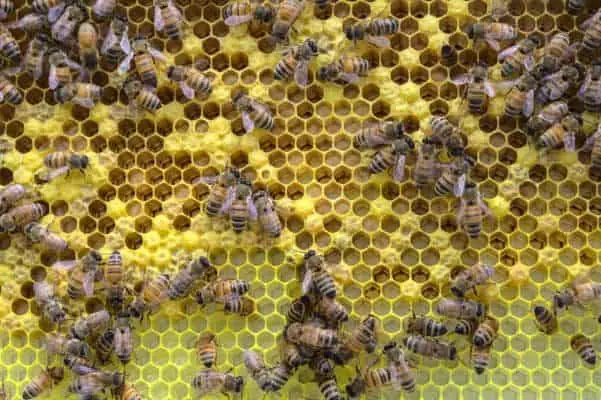
With the increasing number of bees in the spring the hive will be able to bring in more pollen and nectar which will typically result in good stores of honey. The wax production and comb construction also increases to meet the need for brood and honey storage requirements.
As the Springtime bee population and the honey production expands more wax combs are needed. Beekeepers during this time will add one or more supers to the hive, depending on the strength of the honey flow.
Supers are additional boxes containing frames that the bees can build their wax combs on. The supers give the bees the space they need for all the extra bees and room to store the pollen and nectar they are collecting on the foraging flights. For the beekeeper, the extra space a super provides reduces the chance of the bees in the hive swarming.
These wax combs are actually reusable. The bees can reuse them multiple times. Initially it takes a lot of resources to make wax and build combs, however the hard work is an investment in future growth of the hive for the bees.
What happens to the wax combs when they are full of honey?
Full wax combs mean it’s time to extract the beautiful honey ready for consumption. The wax combs in the full honey frames are traditionally extracted by using a clean hot knife. The Beekeeper runs the knife carefully from top to bottom peeling back the capping wax exposing the honey inside.
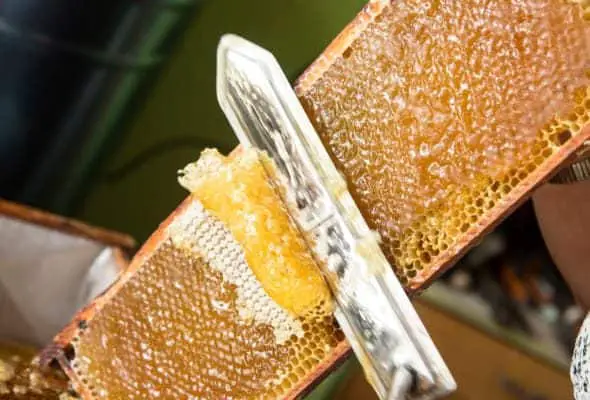
The uncapped, exposed wax cells on the honey frame are spun in a special machine called a honey extractor. The centrifugal force from the spinning frame discharges the honey from the cells without damaging the cell structure.
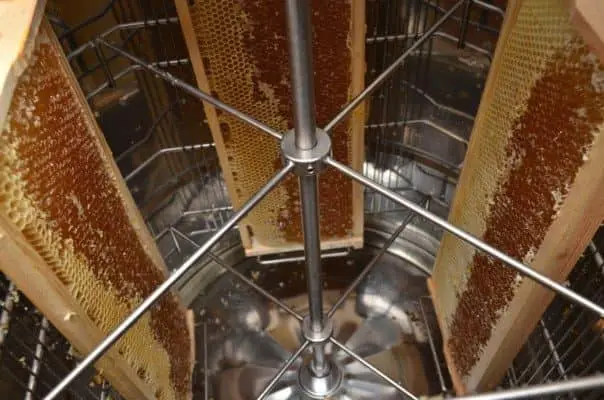
Some backyard beekeepers opt to remove the combs completely to either sell the whole capped honeycomb or use a crushing method to extract the honey. This method is not overly efficient.
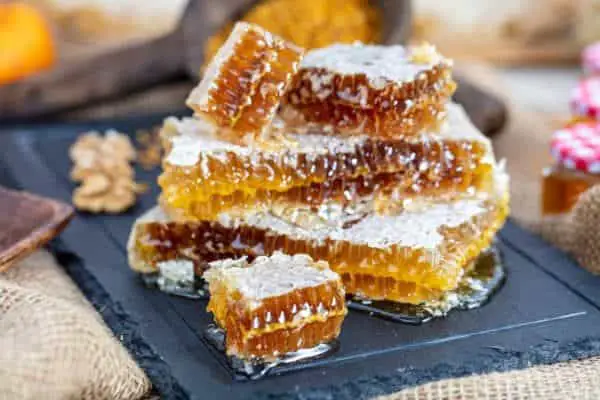
You will find most beekeepers practicing this method will eventually invest in an automated extraction machine. You can get the appropriate sized extractor based on the amount of hives you are tending to.
Once the extraction process is complete, the empty frames often referred to as ‘sticky frames’ are returned to the original hive. Without delay, the bees get to work cleaning and repairing cells ready for the queen bee to lay eggs or for the workers to store a fresh batch of honey.
How much wax can a bee produce? Let’s look at the numbers.
Wax production commands huge amounts of bee power from the hive. A wax producing honey bee will consume approximately 8.4kg of honey to produce 1kg of wax. To understand what a mammoth task this is for the bee to produce just 1kg we need to do the maths.
A single worker bee can produce eight flakes of wax in a 12 hour period. These fresh wax flakes are tiny, measuring only 0.001 of a gram per flake. If a single worker bee can produce 0.008 of a gram of wax in 12 hours, it therefore takes 12 hours for 125 worker bees to produce just 1 gram of wax.
Now consider this…….If a hive has 15,000 bees of wax producing age available it would take them 100 hours to produce 1kg of wax. This is just the time it takes to produce the wax flakes, what is not accounted for is the time required for other bees to collect the wax flakes and process that wax ready for building or repairs to the combs. The figures are truly astounding.
How do bees build combs with wax?
Worker bees collect the wax flakes using their mandibles and put the flakes in their mouths to chew. Mandibles are located on each side of the bees mouth protecting their proboscis, bees use their mandibles like a multi-purpose tool.
Below you can clearly see the mandibles of the bee. Her proboscis tucks up behind the mandibles when she is not using it.
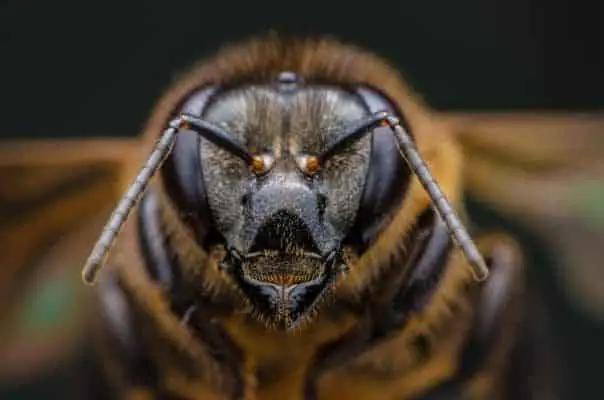
Hive temperatures typically about 33-36℃ (91-97℉) this creates an ideal wax consistency for the bees to chew.
When the bees chew the wax it blends with enzymes from their mouths which helps to masticate the wax into manageable pieces. The bees use the chewed wax to build perfect hexagonal cells, meticulously positioning the fresh wax until each cell is the sufficient depth for honey storage or brood production.
These perfectly cultivated cells are polished by worker bees then await inspection and approval by the queen bee. She will not lay in a cell that is not perfect in dimension and cleanliness.
You can see in the image below the marked queen has her abdomen down in a cell laying her egg.
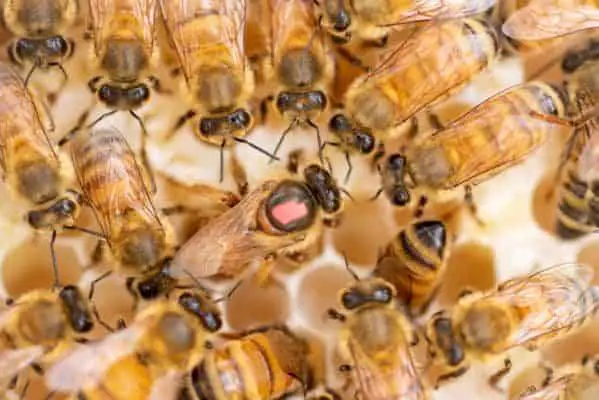
How do beekeepers manage honey bee wax production?
If bees are left to their own devices they will build hives in hollow trees, walls, roofs, floors even cavities of buildings. In these environments they will build combs to suit the available space in the cavity.
The hive below has found its home in a hollow of a fallen tree.
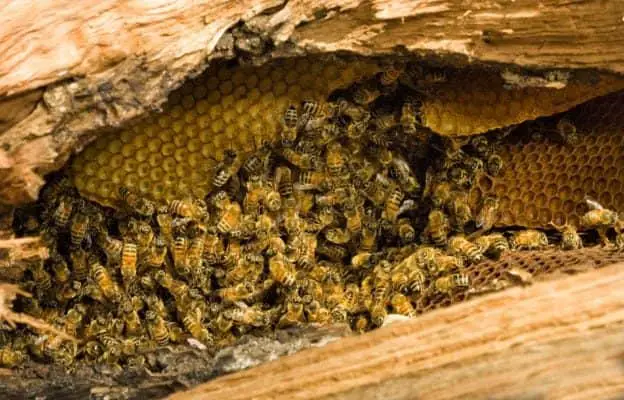
Beekeepers have developed a variety of beehive designs in order to manage the way the bees build their wax combs. Creating a controlled/conducive environment for the bees allows them to thrive, and ultimately creates a platform for max honey production.
The most common beehive design is the Langstroth system. In a Langstroth hive, beekeepers place frames in a hive to control where and how bees make their combs.
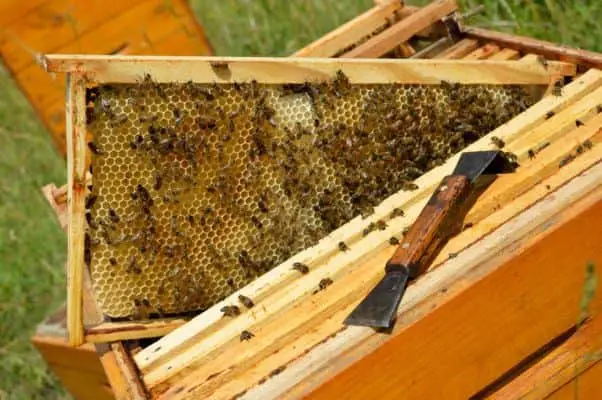
When a frame is first introduced, it has a full foundation frame of beeswax with the hexagonal patterns of the cells ready to be drawn out by the bees. They consist of 8 to 10 frames per box. As the hive grows in strength the beekeeper will stack the boxes on top of each other.
Another design is a top bar hive. The top bar frame has a starter strip of foundation wax attached to the top bar of the frame. The bees can develop the wax combs from the starter strip as needed. These hives are often in one long box and expand horizontally rather than vertically.
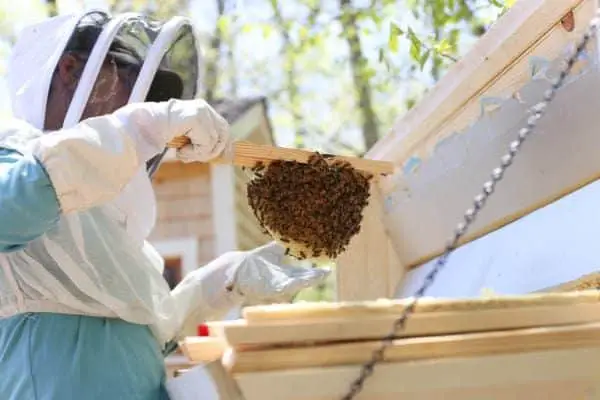
What is festooning and how is it important to wax comb construction?
There are a number of theories regarding the purpose of festooning. Most commonly it is thought that a chain of conjoined bees technically referred to as festooning is the bees producing the next build of wax combs. The bees are communicating measurements for the construction of these wax combs.
Below is an example of bees festooning on a top bar frame.
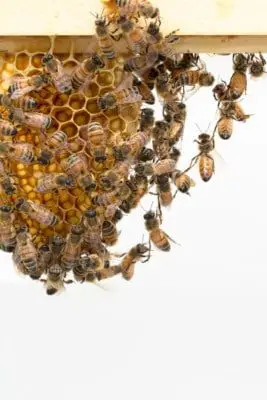
Bees are very industrious and they don’t like voids in their hives. When we extract honey from the hives near our shed, frames may be out of the hive for two or three hours before whilst we are extracting before we return the sticky frames back to their hives.
We often observe festooning in full swing when we return to replace the frames. There will be chains of bees hanging from the lid of the hive in the void where the frames were. If we were to leave a frame out for a day or two, a strong hive would have already made significant combs hanging from the lid of the hive.
Correct “Bee Space” reduces unnecessary beeswax.
The legend of beekeeping Lorenzo Langstroth, responsible for the Langstroth hive design and used by the majority of beekeepers worldwide. Langstroth made a significant observation in 1851 that honey bees, given a space of 6mm to 9mm, would not produce wax combs or propolis in these spaces. The Langstroth hive design takes this “Bee Space” into consideration.
If the space is larger than 9mm the bees will build burr combs. These burr combs from a beekeeper’s perspective make the hive harder to work with because lids, boxes and frames are stuck together by the burr comb and propolis.
Furthermore the goal for the beekeeper is maximum production of honey and the production of wax as discussed earlier requires the consumption of a lot of honey. If the space permits the bees will store honey and on occasion build drone brood in the burr comb.
How do you get wax out of the beehive?
Beekeepers will remove frames of capped honeycomb from the hives and extract the honey. During the extraction process the beekeeper will remove the top layer of wax capping from the honeycomb. Once removed these wax cappings are ready to be turned into solid wax to be repurposed into beauty products, wax food wraps etc.
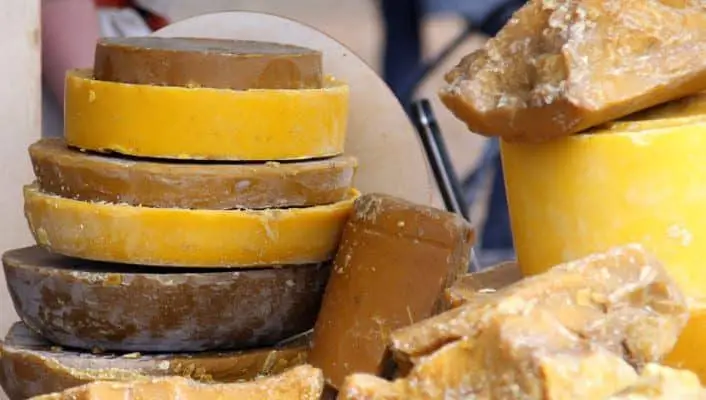
To prepare the wax ready for reuse, the leftover wax is heated. It can be rendered with any honey or impurities still on the cappings as they will sink to the bottom of the heated, liquified wax. Once cooled, the solidified wax should be clean and ready to be sold.
What color is beeswax?
When the worker bees collect the wax flakes they are an opaque white colour. A characteristic of beeswax is its ability to absorb other environmental substances it comes into contact with. For example, pollen and impurities left from brood production. In an aged hive the combs will vary in shades and colour. In most cases the brood combs typically being the darkest.
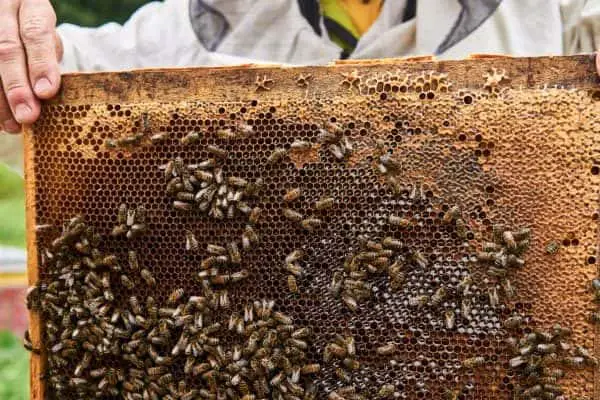
Frames with freshly drawn out wax will be very light almost white in color. As the wax ages and as the wax combs are worked by the bees for storage of pollen, honey or used by the queen bee as brood combs, the wax will become increasingly darker.
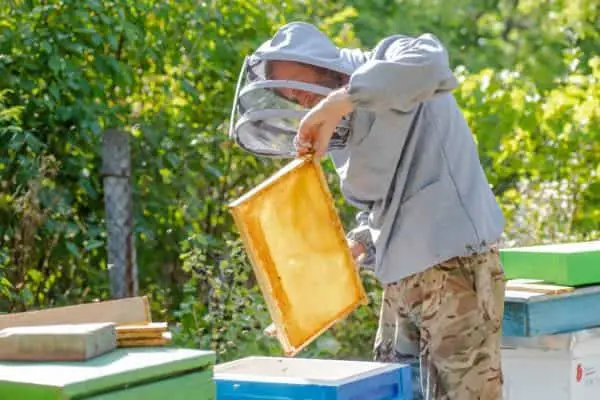
The dark yellow that you often see in processed beeswax is due to the absorption of pollen. Most of the wax combs in the hive will be this color.
Older combs can become almost black in color through the absorption of dust and other contaminants. Beekeepers will tend to replace these frames once they darken in color with a frame that has a foundation sheet in it. The sheet can be made of beeswax or plastic coated in beeswax. The bees will make new combs from this foundation and the process begins again.
